In the check-out line at Grand Union, I spied a magazine cover with kittens spilling out of a jack o’ lantern, the new issue of Jack and Jill. While my mother loaded groceries from her cart onto the conveyor belt, a copy of the magazine rolled by as the very last item. My mother gave me a look. Her weekly grocery budget didn’t include surprises. But she dug in her purse for an extra 35 cents. How could she refuse a nine-year-old who loved to read?
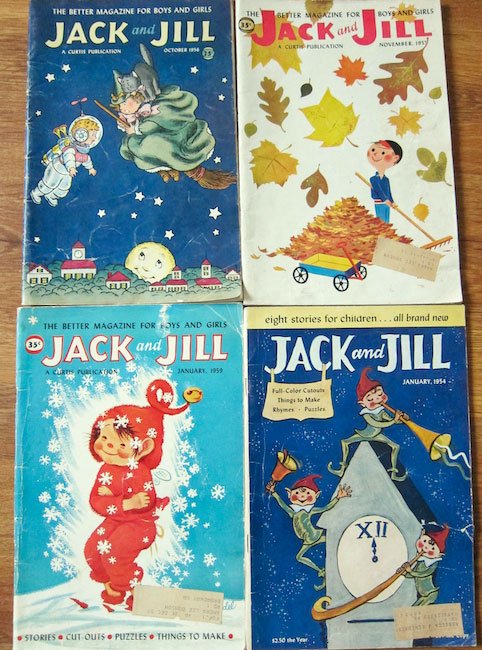
Like most true readers, I read anything in print, including Ladies Home Journal. A magazine just for me was like finding fairy gold. Children’s magazines seem to fall into the category of ephemeral material, not worth examining. A critical paper has been written on the subject, “Historical Overview of Children’s Magazines,” by Elaine R. Abadie. I reviewed her paper for background information, then rooted in my own collection of old children’s magazines.
Children’s periodicals, Abadie states, reflect American history and attitudes about youth. The Children’s Magazine, published in 1789, the year George Washington became president, was filled with moral lessons. In those days, children were meant to stay on the straight and narrow.
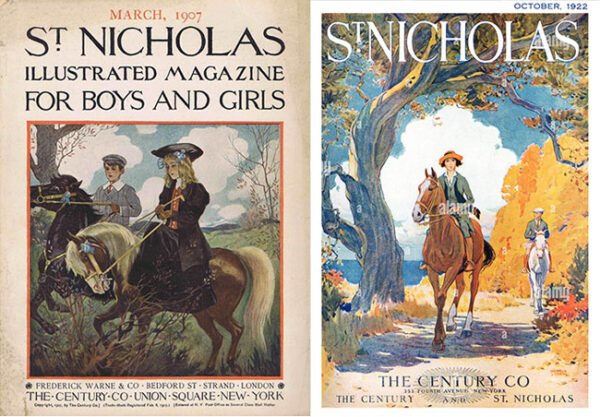
It wasn’t until 1873 when a new magazine for young people burst onto the pious scene. Edited by Mary Mapes Dodge (author of Hans Brinker), St. Nicholas promised to deliver “the cheer of birdsong,” a place for children to play. Contributors included Mark Twain, Louisa May Alcott, Rudyard Kipling, and Frances Hodgson Burnett.
The St. Nicholas League attracted stories, poetry, and art submitted by readers. Winners earned badges and cash prizes. E.B. White, a winner himself, wrote, “The fierce desire to write and paint that burns in our land today [is] directly traceable to St. Nicholas.” Other notable winners include William Faulkner, Rachel Carson, and F. Scott Fitzgerald. The magazine ended its heroic run in 1943. Some say radio may have brought about a decline in readership.
Many magazines were published to varying degrees of success. Years ago, I paid a dollar for an April 1908 Children’s Magazine, edited by Frances Hodgson Burnett. A short-lived enterprise, my copy contains ads to aid “frail anemic children” and “healthy shoes” to prevent pigeon-toes.
The Brownie’s Book (1920−1921) was a noble attempt to give Black children their own magazine, designed to promote “Universal Love and Brotherhood.” Sponsored by the NAACP and edited by NAACP founder W.E.B. Du Bois, it was aimed at all children, but especially “for the children of the Sun.” Langston Hughes’ first poem was published in The Brownie’s Book.
Every Child’s Magazine blew in and out like the March wind, lasting from 1921 to 1929. At 20 cents a copy, it was pricier than most children’s periodicals. My copy has a lovely Art Deco cover in orange and blue, with the content printed in blue. John Martin’s The Child’s Magazine, launched in 1912, boasted authors such as Wanda Gag, Johnny Gruelle, and Thornton W. Burgess. The last issue was in 1933, killed by the Depression.
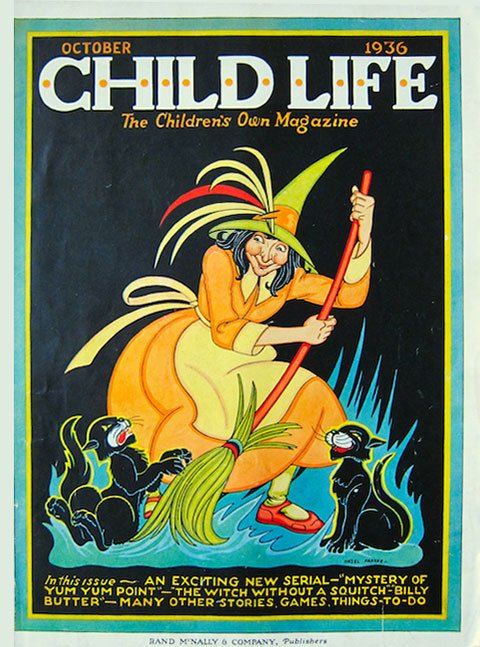
As a collector, I found myself drawn to Child Life from 1930 to 1940, mainly for the striking covers by Illinois illustrator Hazel Frazee. The solid black backgrounds and strong contrasting colors stand out from the usual pastel offerings. Because Halloween was my favorite holiday as a kid, my collection of vintage children’s magazines has many October issues.
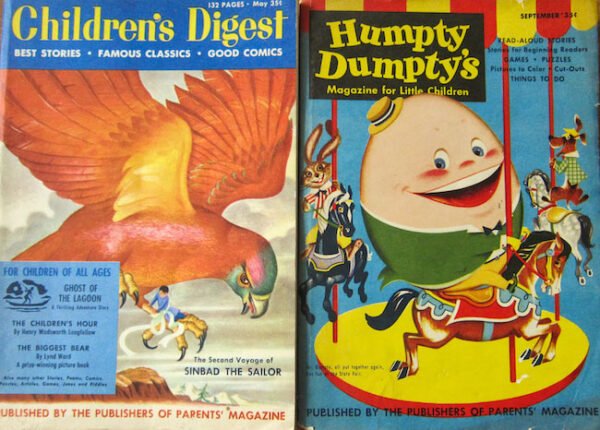
Jack and Jill and Humpty Dumpty were my favorites growing up because they were available in grocery stores. Jack and Jill hit the stands in 1938; Humpty Dumpty in 1952. Humpty Dumpty was pulpy, like its sister publication Children’s Digest (1950), but Jack and Jill was a better size and the paper felt right. Jack and Jill, Humpty Dumpty, Children’s Digest, and Child Life were bought by the Children’s Better Health Institute in 1980 and focused on health, safety, nutrition, and exercise. My favorite magazine was ruined. Just sayin’.
You can’t discuss children’s magazines without mentioning Highlights for Children, begun in 1946 and still going. As a kid, I didn’t like Highlights because of its preachy feature, “Goofus and Gallant.” As an adult, I’m thrilled to know Highlights featured a same sex family in the February 2017 issue. Boy’s Life, now Scout Life, has also kept up with the times.
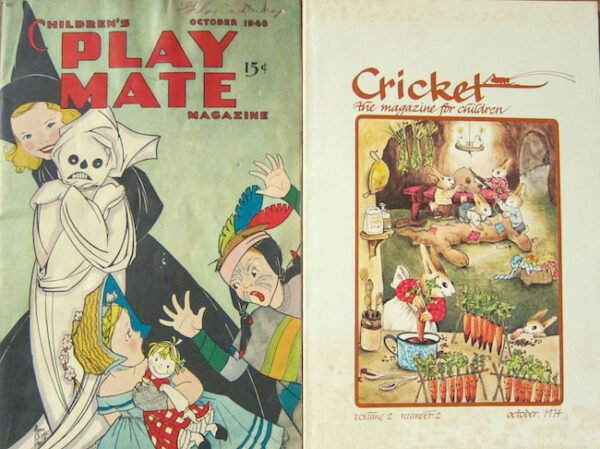
In 1973, Cricket magazine took up the flag dropped by St. Nicholas. Editor Marianne Carus declared the new publication would be “The New Yorker for children.” Art director Trina Schart Hyman set the bar high. My October 1974 issue lists Betsy Byars, Barbara Sleigh, Marjorie Sharmat, N.M. Bodecker, Ann Thwaite, and Erik Blegvad as contributors. It is going strong nearly 50 years later and has expanded its family to include Babybug, Ladybug, Click, Ask, Spider, and Muse.
A magazine I discovered only a few years ago is The Golden Magazine. It flourished in the 1960s, then disappeared. It had the flavor of Golden Books since it used the same illustrators.
I still love children’s magazines. My first published story (a two-parter!) was acquired by Jack and Jill and I felt I had come home. In our house, old children’s magazines are far from forgotten. Several issues of Child Life are framed as art. A rotating stack of vintage Jack and Jill magazines sit in an old child’s wagon as a sort of calendar. At the beginning of each month, I pull out a corresponding issue and enjoy looking at the cover every time I walk past. I’m nine years old again, slipping the latest Jack and Jill at the end of my mother’s grocery order.

Thank you for this delightful information and causing me to relive childhood trips to the pediatrician’s office. The dog-eared copies of Jack and Jill made those visits almost enjoyable!
I only remember Highlights in the dentist’s office and as a kid who read everything with print, it was hard not to leaf through it anyway. I didn’t like the art (picky even at 8 and 9) and felt some of the stories were too babyish (they covered too wide an age range). But Highlights is still around and any children’s periodical that has stood the test of time, like Cricket, deserves applause.
I loved this article, Candice! It brought back many fond memories. When I was a child in the 60’s, I used to receive my neighbor’s second hand copies of Golden Magazine, which she received second hand from someone else. I still remember some of the stories, and of course the jokes by Cracky, the magazine’s parrot mascot. When I was about 10, I began receiving my own subscription to Jack and Jill. What a thrill it was to get something addressed to me in the mail! I remember some of those stories as well, and I bet I would recognize any cover from the time I was a subscriber. Like you, I would… Read more »
Dave, I would have given my eye-teeth for a subscription to Jack and Jill! Many in my collection have mailing labels and I always think about the lucky kid who got that magazine each month. I suspect you remember those covers because it was rare to have a children’s magazine and you probably read them over and over. The Golden Magazine, as I said, was a recent discovery, but it’s such a classy production, sort of an upscale Jack and Jill. I have read E.B. White’s essay about St. Nicholas. The roll call of St. Nicholas League prize winners is astonishing. I’m so glad you got your start in the… Read more »